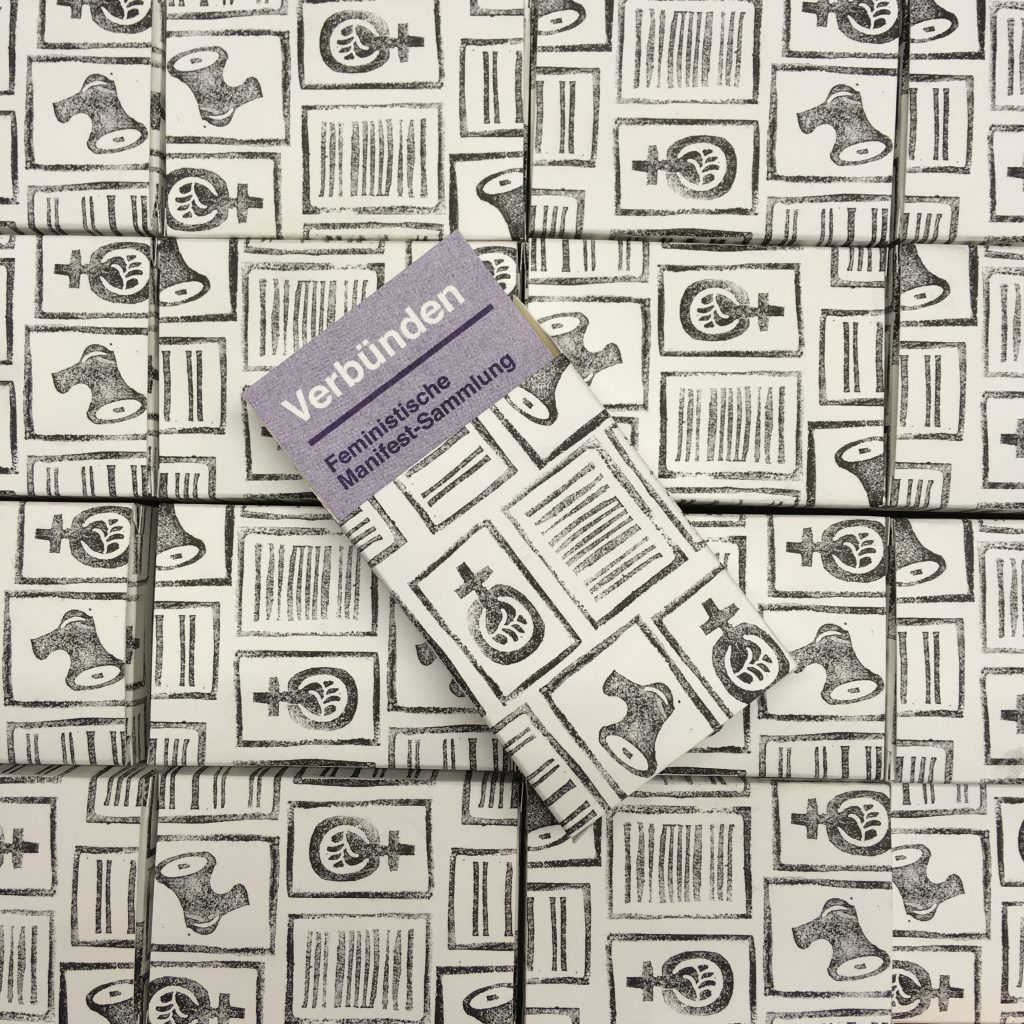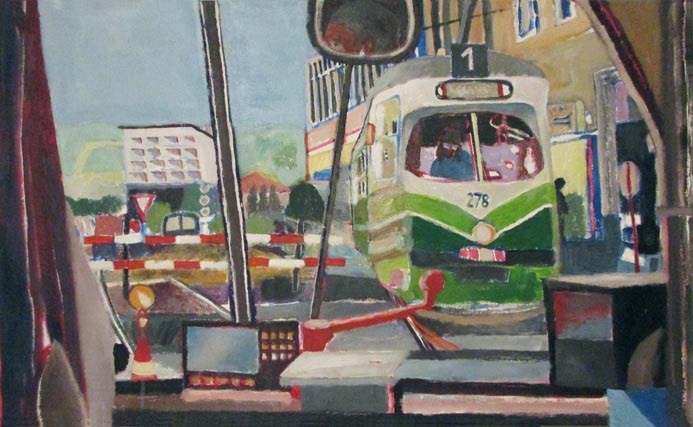Josef FĂĽrpaĂź, BRITISH CONDITIONS 2019/20
MANIFESTOS Ona B., RISOGRAD, Renate Kordon, Josef Fürpaß, Keyvan Paydar, Klaus Dieter Zimmer,  Julian Rosefeldt.
Pao Kitsch (postponed because of Covid 19)
Opening by  art historian Dr.in Edith Risse.
“A spectre is haunting Europe” – with this sentence from the most famous of all manifestos, The Communist Manifesto, we start a roundelay with visual as well as performance artists, architects, musicians, authors and movie makers joining in. Manifestos are texts, in certain cases also enactments, that are brave enough to conceive of something completely new. Considering that the potential of our world to self harm is constantly growing, manifestos as a rebellion against the familiar deserve our attention, no matter whether they advocate conserving nature, total mobility, whether they advocate functional building constructions or the reign of mold, the total economic freedom of the individual or the communization of all property – in fact they might as well advocate to abolish all manifestos…
Artists do always manifest something. Artists might manifest their aesthetic understanding, their choice of media, their materials, it might be their view of the world, their understanding of society, their awareness of being in the world as they show it to others – and in this manner, artists invite us to critically engage with their manifestations.
ONA B. / FACE 2 FACE – KUB 2020 27.03
“FACE 2 FACE” 2020 (Video ONA B. + beo projekt, music Robert Michael Weiss) approx. 10 min.
In memory of the performance “EYES OPENING” 1978
Amidst of my red painting I am sitting at a red painted table, focusing on my counterpart: the camera. Only my blonde hair and my face stand out very brightly from this overall picture. Slow gestures are the language. The hands play a big role. I am wearing long red satin gloves. “Not seeing”, “Not hearing”, “Not speaking” are elements of this communication. The repertoire of gestures is reflected in the music. The timeline of the gestures generates the musical score.
“Second Sight – DAS ZWEITE GESICHT”, 2020
[Video ONA B. + beo project; music/sound Robert Michael Weiss] approx. 14 min. Using the wax objects / mouth positions “ROTE LIPPEN” by ONA B., 1979
The wax objects show different positions of my mouth. They show sadness, joy, annoyance, sensuality, they show my complexity. At the time of their creation they were signs of an atti- tude towards stereotypes to which women were subject. Today, superimposing parts of my young face made of wax on my face from 2020 is like unifying my ideas as a young artist with my being of today. Longings for the future from the past mix with the reality of the present. “Second sight” is a term for the gift of clairvoyance, the ability to foresee the future. I have foreseen my path, I have held on to my ideas and worked them out. Furthermore the idea of a death mask comes up – apparently embodied paradoxically by the young face, which opens up several levels. The “Death and the Maiden” motif resonates, scary as well as erotic, where the personified death appears as a seducer or lover of a young woman. Here the young woman represents death, the older one life, here the woman loves herself. In the imagination the young ego loves its ideal, which one day will be its older counterpart and vice versa: the older person loves the courage and perseverance of her young selves. They se- duce each other to unity.
It seems that even Renate Kordon’s line drawings refuse to stay fixed: movement and energy is integral to them, as if they were stills from a continuum. It’s how she is in person too: always in motion, pushing forward. In the exuberant turquoises, mustards and rust-reds she wears, and in her spirited personality, she could be on a mission to bring colour to the world.
These are the driving forces in her art: colour, light and motion, all three used as forms of energy that break down and re-shape time and space. Her shift away from architecture towards animation, then branching into installation, began in her student days. Film, she felt, with its two dimensions and flickering transience, was far more a reflection of the internal workings of a person:“ I didn’t so much want to build walls as to focus on what happens between them.”
The artistic work of Renate Kordon comprises a polymorphous spectrum of techniques and media that can hardly be defined in terms of common style concepts. It includes drawings as well as satirical comics and psychogrammatical picture and object series, animated films and interventions in public space. “Lebenslinien” (Lifelines) offers the first synopsis of her work, which has developed over a number of decades and has always been influenced by the conflict between what is rational/objective, the surreal/subjective, the material and the spiritual as well as the shift of what is real on the surface and the alternative reality of intellectual and emotional states. This volume takes on the theme of these contexts and relations and includes many hitherto unpublished comics, storyboards, work models and photo documents. In this way, an oeuvre that belongs to the international avant-garde in the fields of experimental animation and spatial installations, yet has long been perceived as scattered across many disciplines, is finally given a unifying exploration, rendering and positioning.
RISOGRAD
Know, collaborate, distribute
[Original: Verstehen, VerbĂĽnden, Verbreiten]
Vending machine refilled with 3 kinds of printed matter
2019
What used to be a condom vending machine is turned into a distributor of feminist publications by the Graz based collective Risograd: three different packages contain a chronology, a collection of manifestos and an activist box. These miniature publications look at a feminist critique of society and consider KNOWING, COLLABORATING and DISTRIBUTING the base activities to building feminist knowledge, solidarity and dialog.
In the VERSTEHEN (TO KNOW) section you find a selection of feminist/women* rights activities, acchievments and ongoing struggles in Austria, ranging from the 19th century until today.
In the VERBĂśNDEN (TO COLLABORATE) publication, manifestos, open letters and statements of feminist groups and individuals come together to portray the variety of themes and struggles as well as spheres of feminist movements.
VERBREITEN (TO DISTRIBUTE) contains an activist package with buttons and stickers with 1-word-statements calling for feminist rebellion. In a small leaflet the terms, which are both simple and multi-layered in meaning, are explained and contextualized, however the meaning and intensity of the stickers may vary according to their surrounding.
How does the machine work?
Insert 3×1€ coins and pull the bolt!
The RISOGRAD collective was founded in 2017 and is based in Graz at the artists space Schaumbad – Freies Atelierhaus Graz.

RISOGRAD: Feministische Manifestsammlung
The 13-channel film installation Manifesto created by the Berlin-based artist, Julian Rosefeldt in 2015, pays homage to the moving tradition and literary beauty of artists’ manifestos. An artist manifesto is a statement by an individual or a group of artists, which outlines their motivation and intent. It is a literary form, which began in the early 20th century and is a common feature of each avant-garde art movement.
Tracing the history of the manifesto, Rosefeldt draws on the writings of Futurists, Dadaists, Fluxus, Suprematists, Situationists, Dogme 95, and other movements, and the musings of individual artists, architects, dancers and filmmakers. This installation juxtaposes contemporary characters and scenarios, presenting thirteen text collages which Rosefeldt assembled from dozens of manifestos on thirteen different screens all performed in monologue form by Australian actor Cate Blanchett.
Each monologue runs for approximately 10 minutes and they screen concurrently across the installation. The result is a call to action, which ultimately questions the role of artists in today’s society.
All of the monologues spoken—actually, the only words spoken in the piece—are formed out of various artistic manifestos published over the last 150 years or so. From schoolteacher to homeless man, the thirteen characters embodied by Blanchett pronounce the manifestos of Claes Oldenburg, Yvonne Rainer, Kazimir Malevich, André Breton, Elaine Sturtevant, Sol LeWitt and Jim Jarmusch, among others.

